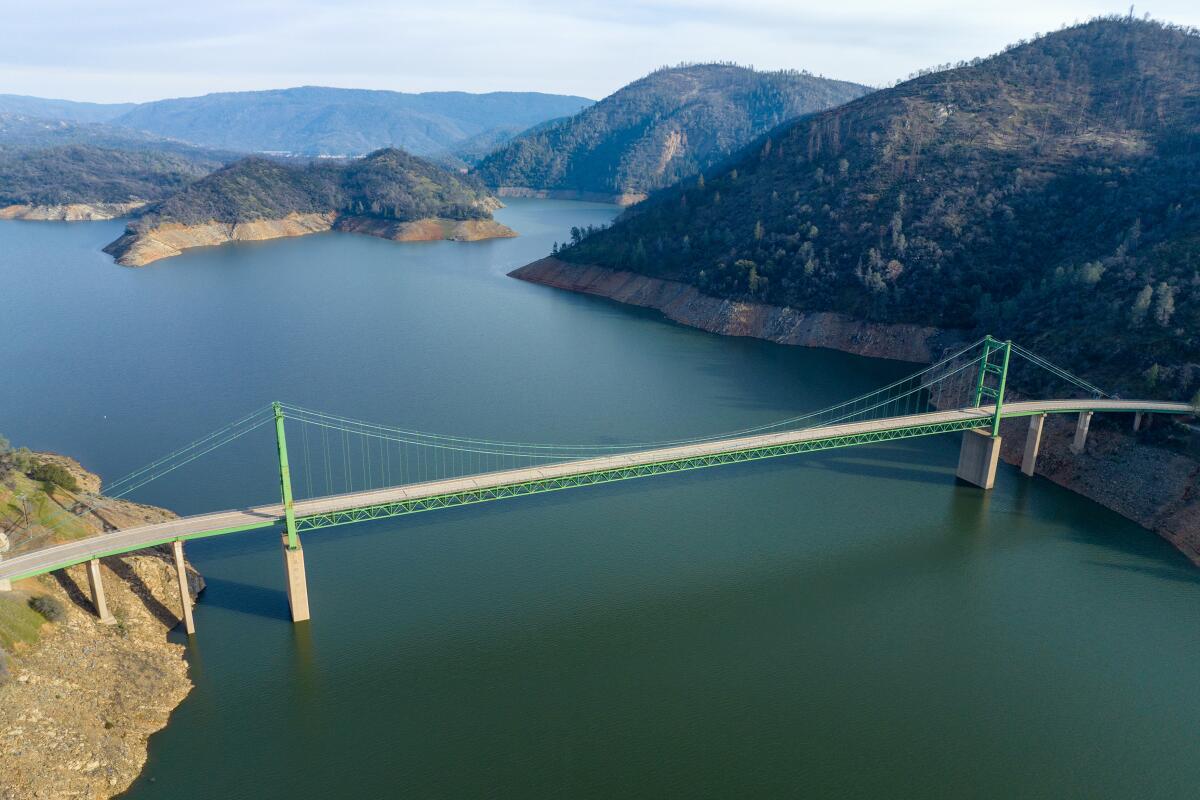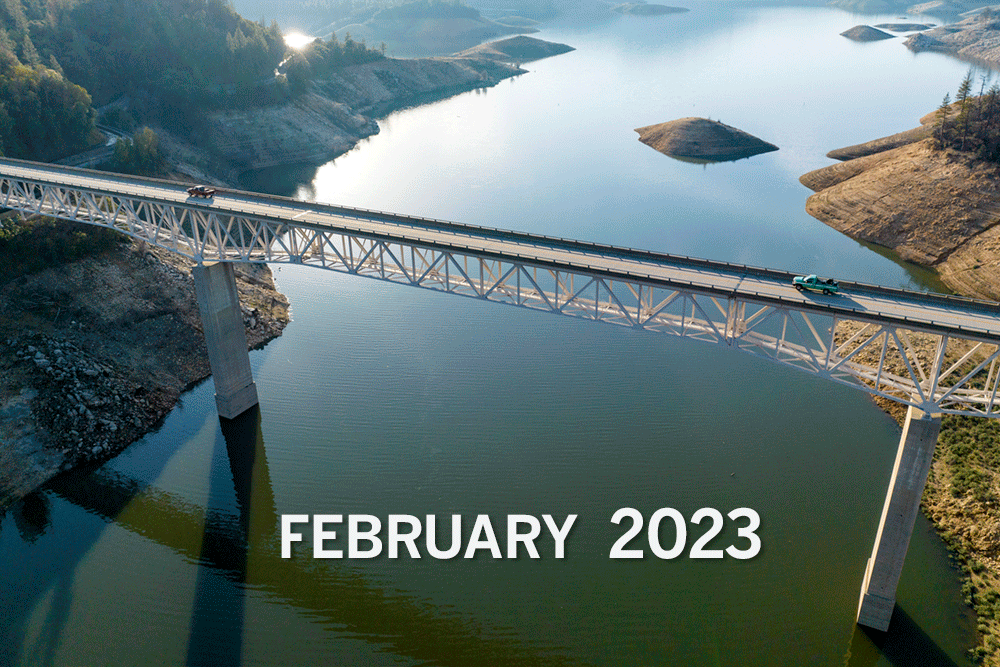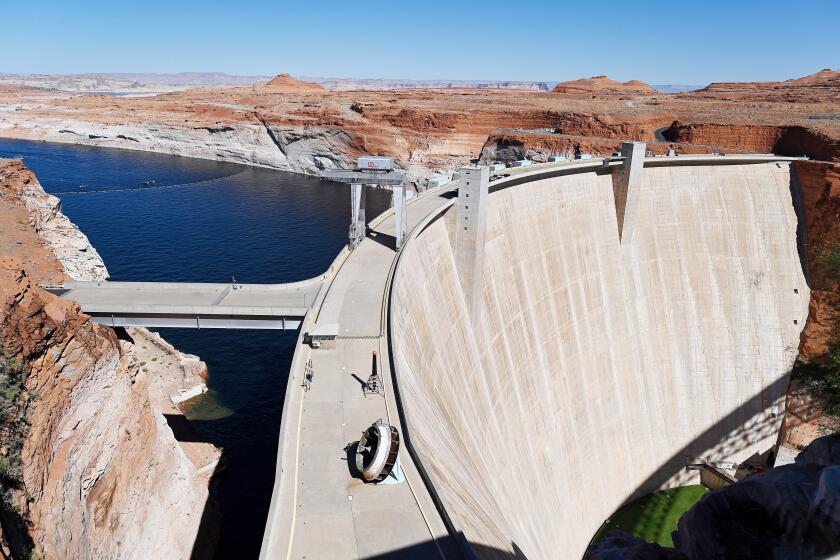Water restrictions lifted for millions in SoCal, but region still urged to conserve

- Share via
Mandatory water restrictions are being lifted for nearly 7 million people across Southern California following winter storms that have boosted reservoirs and eased the severe shortage that emerged during the state’s driest three-year period on record.
Citing improvements in available supplies, the board of the Metropolitan Water District of Southern California has decided to end an emergency conservation mandate for agencies in Los Angeles, Ventura and San Bernardino counties that rely on water from the State Water Project. However, officials urged residents and businesses to continue conserving, and to prepare for expected cuts in supplies from the Colorado River.
The announcement follows an onslaught of atmospheric rivers that have dumped near-record snowfall in the Sierra Nevada and pushed the state‘s flood infrastructure to its limits. It also comes as a new Los Angeles Times/Suffolk University poll shows that 67% of surveyed Los Angeles residents say they still support having mandatory water restrictions this year because of the Colorado River’s severe shortage.
“This year’s very wet weather has improved our water supply conditions enough that we no longer need to mandate the most serious of the restrictions that we had on nearly 7 million people,” said Brad Coffey, Metropolitan’s water resource manager. “But because we have to refill our storage that’s been drawn down by this drought, and because of the longstanding drought on the Colorado River, we’re still asking consumers to conserve. Conserving lets us refill storage and be prepared for another dry year.”
With the rest of the wet season uncertain, officials urge California to keep conserving water.
The MWD had imposed restrictions in June, requiring six member agencies to limit outdoor watering to one day a week or reduce overall use.
The restrictions, which called for a 35% reduction in water use, were intended to deal with critical shortages on the State Water Project, the system of aqueducts and reservoirs that deliver water from the Sacramento-San Joaquin River Delta to Southern California.
Nearly a dozen atmospheric rivers have dramatically eased the water-supply deficit since January. Agencies that depend on the State Water Project received only 5% of their full allocation last year, but with storms boosting reservoirs levels, state officials have told agencies they may receive 35% of requested water supplies this year. That figure is expected to increase even further with yet another storm forecast to arrive early next week.
San Luis Reservoir, one of the large reservoirs that feeds the State Water Project, has risen to 88% of full capacity, and water is being delivered south to boost the levels of Castaic Lake and other reservoirs.
The MWD delivers water that its member agencies supply to 19 million people across six counties.
In December, district officials said that if conditions failed to improve, they anticipated implementing a regionwide allocation to address the shortages, which would have meant a shift to rationing water and mandatory restrictions throughout Southern California.
Now the situation has “turned around enough” that the district won’t need to implement the water supply allocation starting this summer, Coffey said. “We don’t need to take that next step, although we really need consumers to continue to use water efficiently.”
On average, about one-fourth of Southern California’s water supply comes from the Colorado River, where chronic overuse and 23 years of drought worsened by rising temperatures have left reservoirs depleted.
The shortage has prompted federal officials to call for major water cutbacks, and the Biden administration is considering proposals for reducing water use across seven states to prevent reservoirs from reaching dangerously low levels.
Disagreements between representatives of California and other states over how the reductions should be divided, and how the current shortage-sharing rules should be revised, have raised the possibility of legal fights.
Officials from Metropolitan Water District have been participating in talks among the region’s water managers on how to achieve the needed water reductions.
Colorado River in Crisis is a series of stories, videos and podcasts in which Los Angeles Times journalists travel throughout the river’s watershed, from the headwaters in the Rocky Mountains to the river’s dry delta in Mexico.
Recent storms have delivered above-average snowpack to the Colorado River Basin, but one wet year won’t erase more than two decades of water deficits in the river’s giant reservoirs, Lake Mead and Lake Powell.
“We know that the seven basin states need to continue moving forward on a plan to cut the use of the river water,” Coffey said. “We are intent on continuing to use that water as efficiently as possible, such that we can help support the levels of water in Lake Mead.”
Lake Mead stores water used by farms, cities and tribes in California, Arizona, Nevada and northern Mexico. The reservoir near Las Vegas now sits at 28% of its full capacity.
“Southern California remains in a water supply deficit,” said MWD board member Tracy Quinn. “The more efficiently we all use water today, the more we can keep in storage for a future dry year.”
Adán Ortega, Jr., chair of the MWD board, said the last nine months under mandatory restrictions meant sacrifices for people in cities that rely on the State Water Project. He praised “remarkable efforts” that achieved the needed 35% reduction in water use.
“I want to express our deep appreciation to all those who helped us stretch our available water supplies to get us through the acute emergency,” Ortega said.
While MWD is no longer requiring restrictions, local water suppliers may still have mandatory watering rules in place. The district said Southern California remains under a “water supply alert,” and called for a continued focus on reducing water use.
Adel Hagekhalil, the district’s general manager, said the region’s water supply challenges are far from over. He said Southern California faces “major uncertainties” in the supplies it receives from the Colorado River.
“We ask everyone to remain diligent in saving water regardless of the weather,” Hagekhalil said.
The Colorado River’s decline threatens hydropower at Glen Canyon Dam. Now, officials are looking at retooling the dam to deal with low water levels.
As climate change causes more rapid and intense weather swings, water managers are facing increasing challenges. Adaptation, Hagekhalil said, will require greater reliance on local water supplies, including by investing in a large wastewater recycling project in Southern California.
The series of storms this winter have eased drought conditions across California, according to the U.S. Drought Monitor.
But many people in Los Angeles continue to see a need for water restrictions, according to the new poll.
The poll, which surveyed 500 adult residents in the city from March 9-12, asked: “California got a lot of rain in January and snow in February. In your opinion, do you think the drought that California has been dealing with is finally over — yes or no?”
In response, 61% of L.A. residents said no, the drought is not over, while 10% were undecided and others said the drought is over or declined to answer.
Similarly, 60% said that public officials have been largely accurate in what they’ve said about the drought. And 67% of Angelenos said they support continued mandatory water restrictions this year because of the Colorado River’s severe shortage. Those views were consistent across lines of race, ethnicity and income.
There were some differences along political lines. Republicans were much more likely than other L.A. residents to say that the drought is over and were divided over whether to support further water restrictions.
The poll, which involved live phone interviews in English and Spanish, had an error margin of 4.4 percentage points.
Scientific research has shown that global warming is bringing more intense droughts and floods. Scientists have also found that climate change is driving the aridification of the Southwest, and that roughly half the decline in the Colorado River’s flow since 2000 has been due to higher temperatures.
Water managers and researchers say California must be prepared to adapt to a hotter, drying climate in which severe droughts are punctuated by sudden bouts of extremely wet weather.
“We need to change our language from ‘in a drought’ or ‘not in a drought,’ because we’re really in a period of changed climate. And that’s what we need to adapt to,” Coffey said.
“What we’re really seeing is what we term climate whiplash, and we know that severely dry conditions could return as soon as next year,” Coffey said. “We need to plan and prepare our systems to be as adaptable as possible.”
Times Senior Editor David Lauter contributed to this report.










